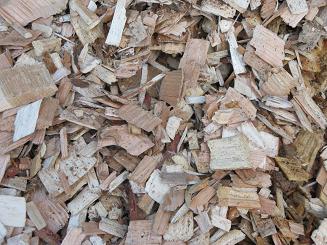Silvicultural Implications in Small-Diameter Woody Biomass Utilization
Small-diameter trees have historically been utilized for the manufacture of paper, particleboard, fiberboard, and other reconstituted products. However, because of the shutdown of many paper mills, the demand for these trees has been dramatically reduced. In areas where the demand for pulpwood has declined, there is frequently an opportunity to utilize small-diameter woody trees and occasionally shrubs for bioenergy.
Thinning is the silvicultural practice of reducing tree numbers in a stand to favor the growth and health of the remaining crop trees. A stand might be thinned several times during a rotation (in the case of even-aged management) or each time a compartment is entered for harvesting operations in stands managed using uneven-aged techniques. Thinning of sprouts is often undertaken for coppicing species to favor one to three sprouts per stump. Although foresters recognize different types of thinning, the most common silvicultural practice for conifer stands is the removal of the smaller, weaker, and most deformed trees; this is known as thinning from below or low thinning (Schultz, 1997; Smith et al., 1997).
In hardwood stands, crown thinning, sometimes called “crop tree release,” is recommended (Hicks et al., 2004). With crown thinning, trees are removed from the same level in the canopy to favor desired crop trees. Sometimes the first thinning(s) occurs when the trees are too young or small to be used for commercial products such as posts and poles, sawtimber, or pulp; this is called a pre-commercial thinning. As a general rule, commercial thinning of plantations requires removing about 600 to 1,000 cubic feet/acre of logs to be economical, although in a few situations volume removals as low as 300 cubic feet/acre may be economically feasible (Saville and Evans, 1986; Shepherd, 1986). In Finland, pre-commercial biomass harvesting yields 500 to 1,800 cubic feet/acre of loose chips, while residues from commercial thinning operations range from 700 to 1,800 cubic feet/acre of loose chips (Hakkila, 2004).
Thinning for bioenergy is possible where the thinned trees cannot be sold to higher-value markets. Traditionally, the least valuable roundwood product is pulpwood. Depending on energy prices and the supply and demand for pulpwood, it is possible for a bioenergy market to compete directly with the pulpwood market or to create new opportunities for production thinning where a pulpwood market does not exist. Furthermore, because the bioenergy market has lower quality constraints than pulpwood and can incorporate some crown material, it may facilitate commercial utilization of trees that have traditionally been pre-commercially thinned and left on-site as unutilized residue.
When densely stocked stands are left unmanaged, natural thinning occurs as the more vigorous trees overtop and suppress the less vigorous trees. In mixed stands, a more complex process of changing species dominance and stratification occurs due to differences in shade tolerance and height growth patterns (Smith et al., 1997; Hicks, 1998). As these dense stands develop, they become more susceptible to natural disturbances such as fire, insects, and disease. The proactive approach is to make a sanitation cut (sanitation thinning), which removes the dead and weaker trees to reduce the spread of disease or injurious insects (Smith et al., 1997; Hicks, 1998). In addition, smaller trees can be thinned from stands to reduce fire risk by eliminating potential ladder fuels. Much of this material will be smaller trees suitable for bioenergy.
Thinning and sanitation cuts are often financially attractive. Thinning promotes the growth of the most valuable trees and shortens the time to harvestable size. Sanitation cuts reduce hazards in stands and also promote the growth of crop trees. Thus, as long as the net cost of harvesting trees for bioenergy is lower than alternative practices, it will be an economically worthwhile investment.
Because the primary aim of thinning treatments is to improve the quality, growth, and health of forest stands, it is critical that harvest entries minimize the amount of damage to the residual stand as well as overall site productivity.
